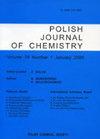Ambivalent Nucleophilicity of 1,4,5-Trisubstituted Imidazole-2-thiones in Reactions with Dimethyl Acetylenedicarboxylate and Phenylisocyanate
引用次数: 3
Abstract
The 1,4,5-trisubstitued 2,3-dihydro-1H-imidazole-2-thiones 1 react with electrophilic reagents via the S- or the N(3)-atom. The reaction with dimethyl acetylenedicarboxylate in methanol at room temperature occurs by the nucleophilic addition of the S-atom to give the corresponding 2-[(1H-imidazol-2-yl)sulfanyl]fumarates 4 in high yield. On the other hand, imidazole-2-thiones 1 react with phenylisocyanate in dichloromethane at room temperature to yield 2,3-dihydro-2-thioxo-1H-imidazole-1-carboxamides 5. The structures of both types of adducts were established by X-ray crystallography.1,4,5-三取代咪唑-2-硫酮与二甲基乙酰二羧酸酯和苯基异氰酸酯反应的亲核性
1,4,5-三取代2,3-二氢- 1h -咪唑-2-硫酮1通过S-或N(3)-原子与亲电试剂反应。在室温下,通过s原子的亲核加成反应生成相应的2-[(1h -咪唑-2-基)磺胺基]富马酸酯。另一方面,咪唑-2-硫酮1在室温下与苯基异氰酸酯在二氯甲烷中反应生成2,3-二氢-2-硫氧- 1h -咪唑-1-羧酰胺5。用x射线晶体学确定了两种加合物的结构。
本文章由计算机程序翻译,如有差异,请以英文原文为准。
求助全文
约1分钟内获得全文
求助全文

 求助内容:
求助内容: 应助结果提醒方式:
应助结果提醒方式:


